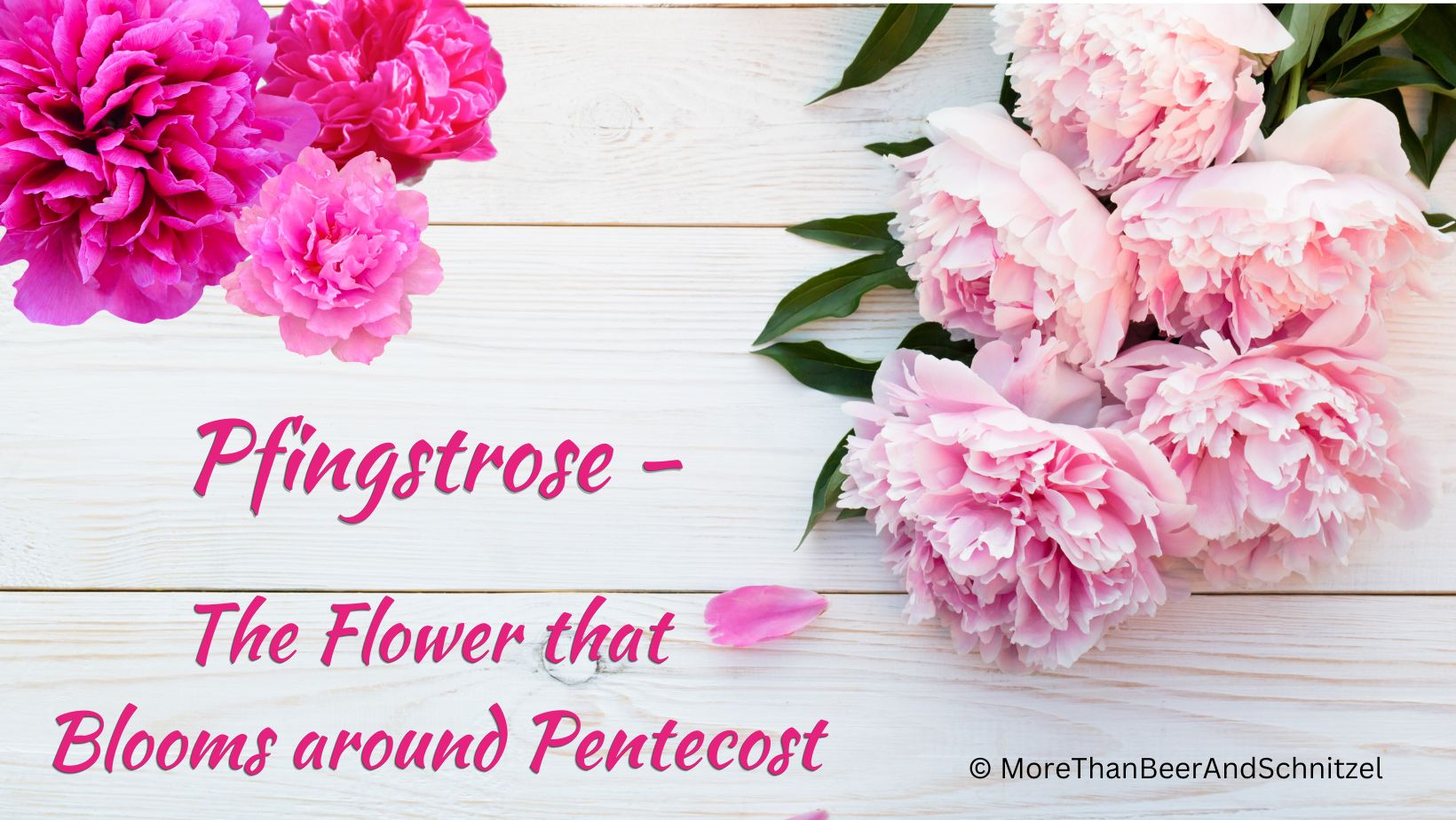The Pfingstrose, also called Päonie (peony), gets its name from its looks (Rosen, roses) and its blooming time (Pfingsten, Pentecost or Whitsun) which is 50 days after Easter. Pfingsten is also called die Ausgießung des heiligen Geistes when the Holy Spirit descended on the apostles and disciples of Jesus. In English, the name of the flower is peony and has no connection to the Christian holiday of Pentecost.


How the Peony got its Name
The names Päonie and peony is derived from the Greek “paionia” which refers to Paeon who was the physician of the Greek gods and student of Asclepius, the God of medicine and healing. Paeon brought the wrath of his teacher upon himself when he extracted a milky liquid from a peony in order to save Pluto who was wounded in the war for Pylos. Zeus was able to save Paeon from Asclepius by turning him into a peony. Or maybe it was Pluto who transformed Paeon’s dead body into the flower.
The healing powers of the peony are also mentioned in Virgil’s Aeneid. Artemis uses the flower to bring Virbios back to life after his father’s horses killed him.
A different myth tells of a nymph named Paeonia whose beauty caught the attention of the Greek god Apollo. Aphrodite saw the two bantering and grew angry insulting Paeonia so harshly that the nymph blushed in shame. Aphrodite then turned the blushing nymph into a flower, the peony.
Whichever story is true (?), the peony has been used as a medicinal plant for centuries, in Europe and especially in the East. Its root is still a staple of Chinese herbal medicine.

Early History
In antiquity, two kinds of peonies were common as garden and healing flower: Korallen-Pfingstrose (wild peony) and Gemeine Pfingstrose (common peony). The Benedict monks took the common peony across the Alps to cultivate it in the monasteries in Middle Europe. After the Benedictines, the Pfingstrose is also called Benediktinerrose. By the Middle Ages, peonies were appreciated not only as a medicinal flower but also as an ornamental plant.
In paintings, the Pfingstrose stands for wealth, healing, health, and beauty as well as maternal comfort. One of the first European paintings that shows the peony is the Paradiesgärtlein (Little paradise garden) from 1410/20 that depicts all Marienblumen (Mary’s flowers). You will, however, find the peonies more often in Chinese and Japanese art than in European art.


Medicinal Plant
In the Middle Ages, the peony was used against gout, that’s why the peony is sometimes referred to as “Gichtrose” (gout rose). Hildegard von Bingen suggested using the seeds when a person was losing their mind and against epilepsy (Fallsucht, falling sickness).
In Bavaria, the seeds are strung on a necklace and help teething children. The seeds are called Apolloniakörner (Apollonia seeds, kernels) after the patron saint for dentistry and all people suffering from toothaches, Apollonia.
The peony roots wrapped in red cloth or pearls whittled from the roots and strung up help against all kinds of harm and protect chidlren from fever and nightmares.
The leaves of the flower were used for skin problems, the roots helped with cramps and other intestinal problems.



St. Apollonia was a virgin martyr who died in 249 AD in Alexandria, Egypt. Her torture included pulling out and/or smashing her teeth. St. Apollonia is therefore often depicted with pliers and a tooth. She is the patron saint of dentist and is called upon for all teeth related problems.
Magical Plant
It is a small step from a medicinal plant to a magical plant. It is said that when you dig up the root of a peony at midnight (during a moonless night) you can use it like a Springwurzel. With a Springwurzel you can open locks and doors and it might even lead you to hidden treasures.
In fairy tales and sagas, it is the Solomon’s-seal (Salomonssiegel) that opens locked doors and forces springs come from rocks. But at the time of these stories, humans weren’t able to find these Springwurzeln and had to be tricky to get ahold of one. Only the Green woodpecker (Grünspecht), or alternatively the magpie (Elster) or hoopoe (Wiedehopf), knew where to find the magical root.
The strategy was to block the woodpecker’s nest with a piece of wood. Since it couldn’t get in, it would fly away and retrieve a Springwurzel. Placing it in front of the blockage would make the wood fly off. At that point, the person should make a loud noise for the woodpecker to drop the Springwurzel. You can also place an orange or red piece of cloth below the nest, so that the woodpecker would drop the magic root onto it thinking it was fire. Since woodpeckers are very protective of the magic key and don’t want anybody else to have it they seek to destroy it.
Obviously, the Springwurzel was highly sought after by thieves and people looking for treasure. There is a wide variety of this story, depending on the region.




Greetings from Florida! I’m bored at work, so I decided to browse your site on my iPhone during lunch break. I love the information you provide here and can’t wait to take a look when I get home. I’m surprised at how fast your blog loaded on my cell phone .. I’m not even using WIFI, just 3G. Anyways, awesome blog!